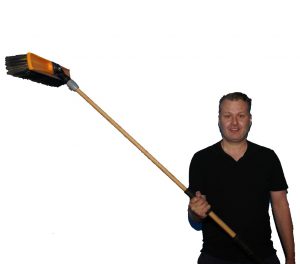Rotation strength
Rotation strength is incredibly important following injury. It helps maintain active range-of-motion gains and it opens a lot of doors (bad hand therapist pun). From twisting open door handles, to opening jars, strength and stability in rotation are required.
The way to strengthen supinators and pronators is with something unbalanced, so the muscles have to resist force in either direction. A convenient way to do this is with a hammer, mallet, stick or broom.
Progressing rotation strength.
The hammer makes a convenient start, but as it only weighs 450g with a lever of 300mm (typical claw hammer), it will get a patient strong enough to turn an easy door handle, but not strong enough to open a jar. For satisfactory strength, something heavier or with a longer lever is required. That is where the mallet, then stick and broom are essential. Any can be modified for easier or harder lever as the patient progresses.
If a patient doesn’t feel resistive exercise is difficult, or they haven’t progressed in a little while, then often it’s time to see how they progress at the next level.
Resistance “weight” & leverage
A larger or heavier object adds resistance. Especially when the weight is at the end of a longer lever. This makes for a mechanism of adjusting resistance.


The larger broom is obviously for those who need maximal strength. A small broom is quite realistic and helpful for most.
Underhand grasp
In this position, a patient can get a good amount of resistance. The key is to move very slowly. If they swing the lever like a pendulum, it will become an ineffective exercise.


Strengthening
There are a few ways to strengthen rotation. Some are ineffective and biomechanically flawed, while others can work and progress from easy to challenging. Given stability and bony union, it is usually reasonable set a goal for strength that exceeds daily function by a little. This means tasks aren’t tough to undertake and the patient has some reserve for harder tasks that may occasionally pop up. And if your patient isn’t challenged or progressing, then of course, the exercise type and intensity can be modified as well as the dose and compliance should be reviewed.
#consult your health professional for individual advice as to whether this exercise is right for you



